The iPhone 5 Review
by Anand Lal Shimpi, Brian Klug & Vivek Gowri on October 16, 2012 11:33 AM EST- Posted in
- Smartphones
- Apple
- Mobile
- iPhone 5
Display: Now 16:9 with full sRGB Coverage
Section by Brian Klug
A huge part of the story of what’s new in the iPhone 5 is obviously the display. At a high level what’s different is pretty simple sounding: aspect ratio is now 16:9, resolution is 1136 x 640, gamut coverage is now almost exactly sRGB, and the digitizer is now in-cell as opposed to on-cell. Let’s go through those changes.
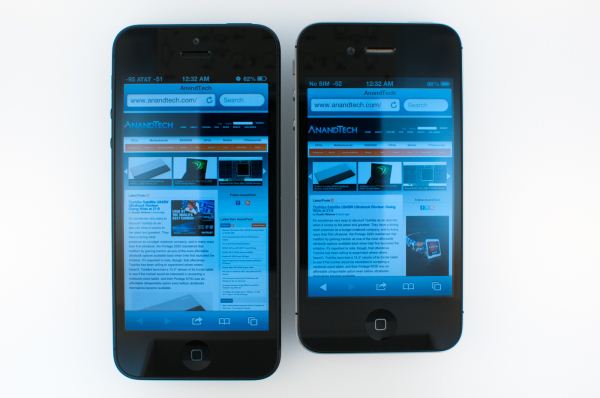
iPhone 5 (left), iPhone 4S (right)
Since the original iPhone days, aspect ratio for the phone has been an immutable 3:2, and later on the iPad adopted an aspect ratio of 4:3. All the while, the aspect ratio wars for content and media have been warring, and by now it’s obvious that 16:9 has won. YouTube changed over to 16:9 just a year after the original iPhone launch, and since then other sources of content have moved that way as well. We saw 16:9 take over as the dominant HD format, and like it or not the same has played out on the PC with a march from 4:3 to 16:10 to 16:9. The move to 16:9 for the iPhone now enables most modern video content to play back without (or with very little) letterboxing, and simultaneously expands the viewport a considerable amount for other applications. A huge number of iOS applications are essentially a list view or a tabbed view with a list down below, and thus are immediately suited in portrait rotation to take advantage of more vertical space. I spend most of my time in portrait mode with rotation locked on iOS, and increasingly it seems as though landscape rotation is a marginalized view for application developers, so this seems to be a sound path forward.
The route Apple chose to get the iPhone to 16:9 is now widely known. They kept width the same at 640 pixels and roughly 5 cm, and instead opted to make the display taller, at 1136 pixels and roughly 8.85 cm, up from 960 pixels and 7.39 cm on the iPhone 4/4S. Interestingly enough 1136 isn’t exactly 16:9, a closer target would be 1137, but we’re talking about one or two pixels that simply get cropped out on video decode and display for most media.
I’ve talked about how Android is now an almost entirely 16:9 camp, and that really frames my thoughts about the iPhone 5’s display size change. In the past, switching back and forth between iOS which was 3:2 previously and modern Android handsets that were 16:9 never felt very extreme. There was a noticeable difference in overall size, sure, but aspect ratio never quite made that big of an impression on me considering the differences in OS. After spending a lot of time with the iPhone 5’s 4-inch, 16:9 display, switching back to the original iPhone format’s 3.5-inch, 3:2 display is a downright jarring experience. It’s readily apparent just how much the platform needed this change in both aspect ratio and size, if nothing else to compete with increasingly larger and larger consumer expectations for display size. It’s interesting as well how discussion about thumb radius sweeping a semicircle out from the bottom corners of the display also quieted down with the change. We’ve talked in the past about how the typical smartphone grip isn’t really centered around the bottom but rather shifted up slightly. I don’t find that the iPhone 5’s larger display changes or diminishes one-handed use significantly at all.
Apple has of course made changes to iOS to accommodate the change in aspect ratio, and those first party applications take advantage of the 176 extra vertical pixels. For starters, the landscape keyboard gets wider keys but doesn’t quite fill up the whole 1136 wide canvas. There’s also another row for applications on homescreens, and another row inside folders.
For third party applications however that road to 16:9 for the iPhone 5 and newest iPod Touch display requires some tweaking, and a trip through the App Store approval process, otherwise you end up with letterboxing. There’s really nothing else that Apple could’ve done besides letterboxing to accommodate older apps that either aren’t updated or will never be updated, but the downside of this centered letterboxed experience is that it shifts portrait apps and the keyboard up by 88 pixels.
A great example of where this is jarring is the IM application I use, imo.im, which hasn’t been updated as of this writing to take advantage of the new viewport size. As a result, typing on this 88-pixel-shifted keyboard requires repositioning one’s grip. This is a temporary grievance though that will go away in time as developers update things, but still warrants mentioning. It’s similar to but not identical to the same kind of friction we saw with the path to retina-enabled apps with the iPhone 4 launch.
In-Cell
The next major improvement is in-cell touch. The iPhone 5 isn’t the first smartphone to include an in-cell touch LCD, but perhaps the first where we’ve seen lots of talk about it. Part of getting to even thinner form factors is either eliminating or reducing the thickness of everything in the z direction. In addition, increasing the light throughput of the display stack (which means both filters and everything between the backlight LEDs and your eye) is a huge driver for overall battery life, since the display is still by far the largest consumer of precious milliwatts in a smartphone.
One of those things is the digitizer, which previously sat on top of the LCD as a separate layer incurring both additional thickness and back reflections. While successive generations of both iPhone display stacks (and the smartphone platform in general) have eliminated a lot of back reflections by reducing the number of air-glass interfaces with optical-grade adhesive lamination (and thus 4 percent Fresnel reflections that go along with each of them), ultimately these glass-adhesive interfaces still incur some path loss and still have a z profile. The only way to reduce these further is to go to in-cell touch, which really is a fancy way of saying that the digitizer is then integrated into the LCD-TFT gating itself, and thus into the cells of each pixel, rather than as a discrete layer atop the stack after color filters.
Getting to this level of integration requires cooperation between both the display driver and touch sensor, and herein lies the challenging engineering problem that in-cell touch poses. Touch sensing has to be time multiplexed with display driving otherwise the touch signal might be entirely lost in noise. At the same time, touch sensing is often around double the frequency (120–175 Hz) of display drawing (60 Hz), so this has to be done carefully during quiet periods, and thus that required communication and integration. The iPhone 5 uses a combination of TI and Broadcom controllers to do display controller and touch sensing, where previous generations of iPhone simply just used a single chip TI solution. In future generations this will come back down to just being a single-chip solution.
Subjectively thus far I haven’t detected any change in tracking quality or performance with the iPhone 5’s in-cell solution, which is great. To end users the difference seems to be totally transparent.
In addition to just the air-adhesive interfaces introducing thickness and unavoidable Fresnel reflections, there’s also the traces from transparent conductors in the digitizer as well to think about. At present that material is Indium Tin Oxide (ITO), which is one of very few known transparent conductors and used inside every LCD. Because Indium is a relatively expensive rare earth metal, ITO traces are only laid down where they need to be on top of and below the glass substrate (for both transmit and receive layers of the digitizer), and the areas inbetween those traces are then filled with an index-matching space fill material to diminish their visibility. How well this space fill is done and how close the index is to ITO’s is one of the quality metrics of a digitizer to begin with, and often these rows and columns are visible under direct illumination either outdoors or with good eyes indoors. Often you can tell a lot about how much value an OEM placed on its entire digitizer just by how distracting these are outdoors, but the big benefit with in-cell is that they go away entirely, which is a huge gain I rarely see people talking about in the context of in-cell improvements.
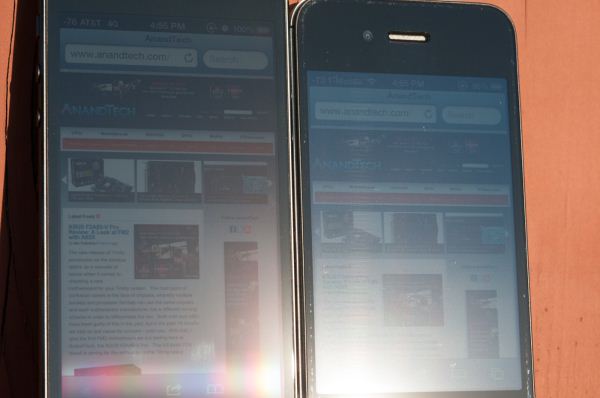
Horizontal lines on the iPhone 4S (right) from the digitizer (easier to see at full size)
That change leads to what I would consider a huge improvement in outdoor visibility, since these lines are now totally gone on the iPhone 5. In addition, there’s no longer a contrast-diminishing set of back reflections from the extra glass layer when outdoors. This is very visible in the photos I’ve taken showing outdoor viewing behavior on both the iPhone 4S and iPhone 5.

Significantly less blue haze on the iPhone 5 (left) than iPhone 4S (right)
Display Quality
Our own Chris Heinonen already did an excellent job characterizing the iPhone 5 display using our new CalMAN 5 based test suite he put together, and I’d encourage everyone to read that for a much more comprehensive version of an iPhone 5 display analysis. There’s really not a whole lot for me to add other than some results from the two other main smartphone displays I’ve tested with this new workflow, and some graphs with data from other phones. Chris has better instrumentation than I do with an i1Pro, but we’ve tweaked the workflow slightly so I ran the iPhone 5 and 4S through the test. In addition Apple has multiple suppliers for the iPhone 5 display so there are bound to be some differences in devices.
Subpixel geometry and size is still the same on the iPhone 5, meaning this is still a “retina” display and all the usual discussion about angular subtense and visual acuity still applies. You can see this under the microscope (all these images are at the same magnification, focus is a bit different though given the different optical path length thanks to that in-cell touch) — both the geometry and pixel pitch are unchanged between the 4S and 5.

To start are our brightness and contrast graphs which are measured at 100 percent brightness. The iPhone is even brighter than the iPhone 4 and 4S displays, at just over 600 nits on my unit. I saw some variance back between the iPhone 4 and 4S in brightness, so depending on where you’re coming from this can be a noticeable jump. Apple started off with good consistency when the iPhone 4 came out, but I saw lots of white point and luminance variance with that form factor display as time progressed and we moved from the 4 GSM to 4 CDMA to 4S.
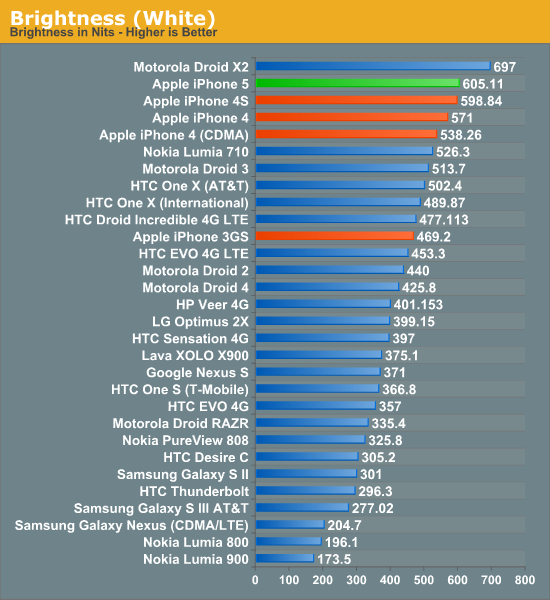
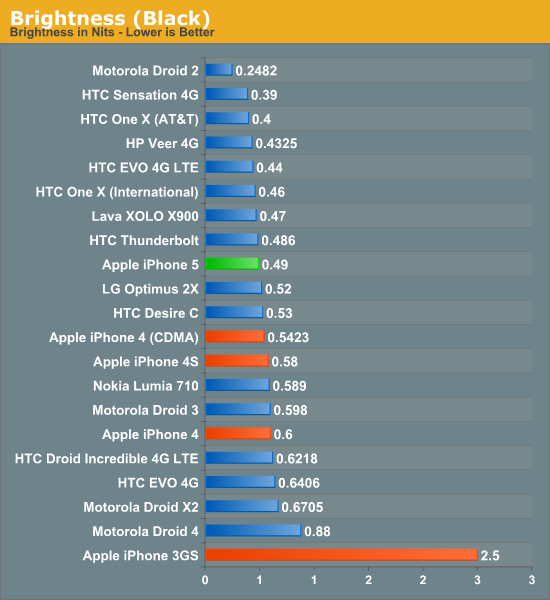
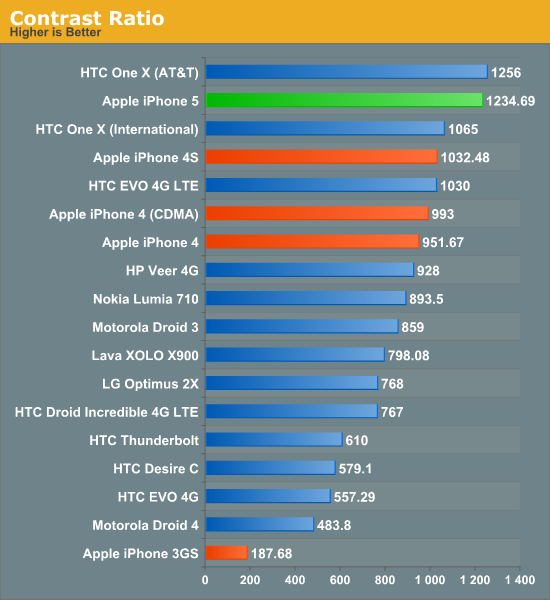
When it comes to gamut, Apple announced that the iPhone 5 display has full sRGB coverage. The iPad 3 was actually first in Apple’s lineup to advertise roughly full sRGB coverage, but it appears that the iPhone 5 is even closer to being spot on. Using our new CalMAN workflow we can easily measure and compare the overall saturations for primaries and secondaries, the ideal values of which are represented by white boxes. There’s a whole lot of measuring required for each phone, so I pared it down to just the iPhone 5, 4S, HTC One X, and Galaxy S 3 for the moment.
Saturations and Gamut
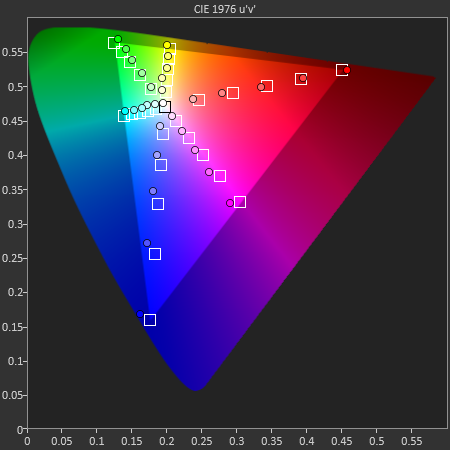
The iPhone 5 is, like Chris said already, the closest smartphone I’ve seen to sRGB to date. It’s really clear to me that Apple puts a strong emphasis on its suppliers to both deliver a display capable of hitting that gamut, and then bothers to do some factory level calibration to get reasonably close. I’ve seen this drift over time but for the time being the iPhone 5 is quite close to being ideal all things considered.
The GretagMacbeth ColorChecker card test colors are next up, and it isn’t surprising here to see some variance, but the values from the iPhone 5 are very close to the intended colors compared to the competition and its predecessor.
GMB Color Checker
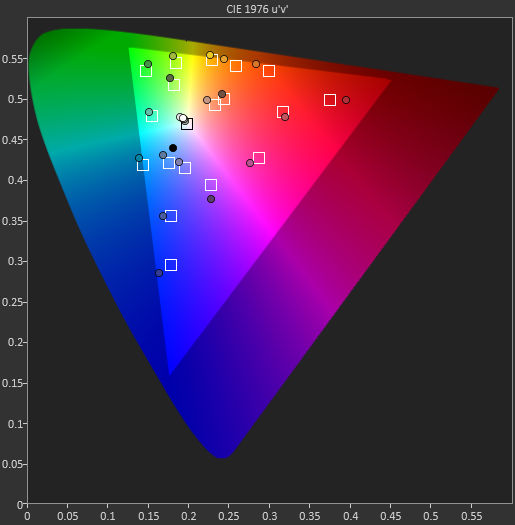
Grayscale and gamma represents our steps of 5 percent grey from 0 to 100 and we get a report for contrast, the white and black levels, color temperature, gamma, and average Delta E 2000 here.
Grayscale and Gamma
My values differ from Chris’ slightly, but my instrumentation and phone are both different from his which may explain some of the differences. The high level story is the same though, the iPhone 5 tracks closer to the ideal than any of the other devices. I’ve also gone ahead and made a table with the average Delta E from each step.
| CalMAN Display Comparison | |||||||
| Metric | iPhone 5 | iPhone 4S | HTC One X | Samsung Galaxy S 3 | |||
| Grayscale 200nits Avg dE2000 | 3.564 | 6.162 | 6.609 | 4.578 | |||
| CCT Avg (K) | 6925 | 7171 | 5944 | 6809 | |||
| Saturation Sweep Avg dE2000 | 3.591 | 8.787 | 5.066 | 5.460 | |||
| GMB ColorChecker Avg dE2000 | 4.747 | 6.328 | 6.963 | 7.322 | |||
Last up is the indoor viewing angles comparison between the iPhone 5 and the 4S, which are essentially unchanged. Even at extreme angles I can’t detect any major differences in viewing angle between the 4S and the 5, which is a good thing since there isn’t really anything to complain about.



















276 Comments
View All Comments
Calista - Sunday, October 21, 2012 - link
English is not my native language (as I'm sure you have noticed) and so the flow in the language is far from flawless. But I still believe my opinions are valid and that the review was too long-winded.Teknobug - Wednesday, October 17, 2012 - link
I live in a big city and I don't know a single person that went and got the iPhone 5, most are happy with the iPhone 4 or whatever phone they're using, I don't see what's so great about the iPhone 5 other than it being built better than the iPhone 4's double sided glass structure (I've seen people drop their's on the train or sidewalk and it shattering on both sides!).And what now? iPad mini? I thought Apple wasn't interested in the 6-7" tablet market, Steve Jobs said 9" is small enough. I know Apple tried a 6" tablet a decade ago but the market wasn't read for it back then.
name99 - Wednesday, October 17, 2012 - link
You know what AnandTech REALLY needs now?A comment moderation system like Ars Technica, so that low-content comments and commenters (like the above) can be suppressed.
Teknobug is a PERFECT example of Ars' Troll Type #1: "Son of the "I don't even own a TV" guy: "
This is the poster who thinks other people will find it interesting that he cares nothing about their discussion or their interests, and in fact judges himself as somehow morally superior as a result. The morphology of this on Ars Technica includes people popping into threads about Windows 8 to proclaim how they will never use Windows, people popping into threads about iOS 6 to proclaim that they never have and never will buy an Apple product, and people popping into Android related threads and claiming that they will never purchase "crappy plastic phones." In these cases, the posters have failed to understand that no one really cares what their personal disposition is on something, if they have nothing to add to the discussion.
ratte - Wednesday, October 17, 2012 - link
yeah, my thoughts exactly.worldbfree4me - Wednesday, October 17, 2012 - link
I finished reading the review a few moments ago. Kudos again for a very thorough review, however I do a have a few questions and points that I would like to ask and make.Am I wrong to say, Great Job on Apple finally catching up to the Android Pack in terms of overall performance? The GS3, HTC X debuted about 6 months ago yes?
Have these benchmark scores from the competing phones been updated to reflect the latest OS updates from GOOG such as OS 4.1.X aka Jelly Bean?
Clearly the LG Optimus G is a preview of the Nexus 4,complete with a modern GPU In Adreno 320 and 2GB ram. I think based on history, the Nexus 4 will again serve as a foundation for all future Androids to follow. But again, good Job on Apple finally catching up to Android with the caveat being, iOS only has to push its performance to a 4inch screen akin to a 1080p LCD monitor verses a true gamers 1440p LCD Home PC setup. Ciao
Zinthar - Thursday, October 18, 2012 - link
Caught up and passed, actually (if you were actually reading the review). As far as graphics are concerned, no smartphone has yet to eclipse the 4S's 543MP2 other than, of course, the iPhone 5.I have no idea what you're going on about with the Adreno 320, because that only gets graphics performance up to about the level of the PowerVR SGX 543MP2. Please see Anand's preview: http://www.anandtech.com/show/6112/qualcomms-quadc...
yottabit - Wednesday, October 17, 2012 - link
Anand, as a Mech-E, I think somewhere the anodization facts in this article got very wonkyI didn't have time to read thoroughly but I saw something about the anodized layer equaling half the material thickness? The idea of having half a millimeter anodized is way off the mark
Typically there are two types of anodizing I use: regular, and "hard coat anodize" which is much more expensive
If the iPhone is scuffing then it's definitely using regular anodizing, and the thickness of that layer is likely much less than .001" or one thousandth of an inch. More on the order of a ten-thousandth of an inch, actually. The thickness of traditional anodizing is so negligible that in fact most engineers don't even need to compensate for it when designing parts.
Hard-coat anodize is a much more expensive process and can only result in a few darker colors, whereas normal anodizing has a pretty wide spectrum. Hard-coat thicknesses can be substantial, in the range of .001" to .003". This usually must be compensated for in the design process. Hard coat anodize results in a much flatter looking finish than typical anodize, and is also pretty much immune to scratches of any sort.
Aluminum oxide is actually a ceramic which is harder than steel. So having a sufficient thickness of anodize can pretty much guarantee it won't be scratched under normal operating conditions. However it's much cheaper and allows more colors to do a "regular" anodize
When I heard about scuffgate I immediately thought one solution would be to have a hardcoat anodize, but it would probably be cost prohibitive, and would alter the appearance significantly
guy007 - Wednesday, October 17, 2012 - link
A little late to the party with the review, the iPhone 6 is almost out now...jameskatt - Wednesday, October 17, 2012 - link
Anand is pessimistic about Apple's ability to keep creating its own CPUs every year. But realize that the top two smartphone manufacturers (Apple and Samsung) are CRUSHING the competition. And BOTH create their own CPUs.Apple has ALWAYS created custom chips for its computers - except for a few years when Steve Jobs accidentally let their chip engineers go when they switched to Intel and Intel's motherboard designs.
Apple SAVES a lot of money by designing its own chips because it doesn't have to pay the 3rd party profit on each chip.
Apple PREVENTS Samsung from spying on its chip designs and giving the data to its own chip division to add to its own designs. This is a HUGE win given Samsung's copycat mentality.
Apple can now always be a step ahead of the competition by designing its own chips. Realize that others will create copies of the ARM A15. But only Apple can greatly improve on the design. Apple, for example, greatly improved the memory subsystem on its own ARM chips. This is a huge weakness on otherARM chips. Apple can now custom design the power control as well - prolonging battery life even more. Etc. etc.
phillyry - Sunday, October 21, 2012 - link
Good points re: copycat and profit margin savings.I've always been baffled by the fact that Apple outsources their part manufacturing to the competition. I know that Samsung is a huge OEM player but they are stealing Apple's ideas. They are doing a very good job of it and now improving on those ideas and techs, which is good for the consumer but still seems completely illogical to me from Apple's perspective. Must be the 20/20 hindsight kicking in again.